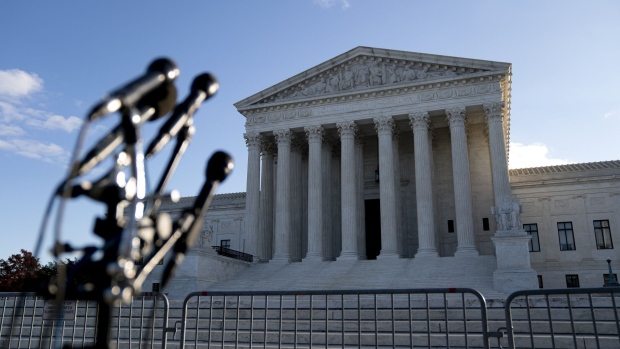May 3, 2023
Supreme Court Takes on Federal Agency Power With Chevron Case
, Bloomberg News

(Bloomberg) -- Conservatives who for years have pushed judges to rein in federal bureaucrats have a chance to claim their biggest prize yet as the Supreme Court considers toppling a 39-year-old precedent that critics say has fueled an explosion of government overreach.
The justices on Monday agreed to hear a case testing the so-called Chevron doctrine, which gives the agencies latitude to interpret ambiguous laws. The implications for government regulations — and by extension, presidential authority — are vast, potentially touching everything from climate change to finance to corporate power.
Presidents of both parties have leaned on the doctrine. A judge invoked it to uphold Donald Trump’s ban on bump stocks, which allow rifles to fire like machine guns. Barack Obama used Chevron to defend a rule encouraging states to adopt more renewable power. And Joe Biden said courts should defer to regulators seeking to expand federal oversight of waterways.
Critics of big government have organized to fight the Chevron doctrine much as antiabortion groups mobilized against Roe v. Wade.
“The Supreme Court has the opportunity to rein in executive power run amok,” said Matt Bowman, senior counsel with the conservative group Alliance Defending Freedom, a non-profit that has fought to pare back federal agency authority since it was founded in the early 1990s.
The case, Loper Bright v. Raimondo, centers on a National Marine Fisheries Service requirement that some vessels fishing for herring off the Atlantic coast hire monitors for conservation and management purposes. Four New Jersey fishing companies are asking the court to invalidate the rule — and overturn or pare back the Chevron doctrine along the way.
Well-funded conservative and libertarian groups, including the Manhattan Institute, Pacific Legal Foundation, Alliance Defending Freedom and Competitive Enterprise Institute, banded together to encourage the high court to take up the case.
The case follows years of critical law review articles and panel discussions by the conservative Federalist Society, said James Goodwin, senior policy analyst at the Center for Progressive Reform.
He called it “a textbook example of the conservative legal movement ‘manufacturing’ a case.”
Historical Precedent
Chevron deference dates back to 1984, when the Supreme Court unanimously upheld the Reagan administration’s interpretation of an air pollution law and a unit of the Chevron Corp. oil company moved to defend it. The justices said that when Congress wrote a statute without a clear meaning, courts should defer to the federal agency applying the law, unless its directives were unreasonable.
For nearly four decades, the principle has guided both federal agencies interpreting muddled directives from Congress and courts imposing their regulations. It’s also provided support for agencies confronting new and emerging challenges — from social media to climate change — without explicit statutory directions from Capitol Hill.
Early on, conservatives embraced the Chevron ruling. The original decision was a victory for the deregulatory agenda of Environmental Protection Agency Administrator Anne Gorsuch Burford, the mother of future Justice Neil Gorsuch. Justice Antonin Scalia hailed the doctrine in a 1989 law review article as providing “needed flexibility, and appropriate political participation, in the administrative process.”
But then their perspective changed.
“Conservative jurists, commentators, began to see Chevron as empowering the administrative state in ways they didn’t like,” said Thomas Merrill, a legal professor at Columbia Law School who has written extensively about the history of Chevron.
Gregory Ellison, an assistant professor of law at Northern Illinois University, said the backlash also came from businesses, including oil and gas companies, as they were affected by agency actions.
Ellison said the “traditional alliance between business and conservatives writ large” drove anti-Chevron sentiment in the mid-2010s.
More recently, Republican-appointed justices soured on the doctrine. Justice Clarence Thomas staked out his opposition in a 2015 opinion, saying it “wrests from courts the ultimate interpretative authority to say what the law is.” Gorsuch wrote last year that Chevron “deserves a tombstone no one can miss.” In 2017, a year before he joined the high court, then-Judge Brett Kavanaugh said Chevron “encourages agency aggressiveness on a large scale.”
Still, the Supreme Court had rebuffed calls to revisit Chevron at least four times since 2019, opting instead to use other means to roll back agency authority. The justices ruled in 2022 that regulators must have clear congressional authorization before acting on “major questions,” such as power plant regulations aimed at stemming climate change.
Iain Murray, a senior fellow at the Competitive Enterprise Institute, one of the groups that has advocated against the Chevron principle, argues it gives too much power to federal agencies.
“Courts deferring routinely to regulators’ interpretation of the law encourages them to aggregate power to themselves while depriving harmed parties of effective judicial remedies,” Murray said.
The court took an unusually long time to decide how to handle the case, scheduling it for potential discussion at five private conferences before announcing the justices would hear one of two questions presented by the appeal. That question asks the court to either overrule or “clarify” Chevron.
The appeal offers the court a narrower path for backing the fishing companies without directly overturning Chevron.
Columbia University’s Merrill said previous cases that pared back judicial deference to the agencies were seen as a “dress rehearsal.” But now, he said, conservatives see the Chevron review as the best opportunity to push their agenda across the finish line.
©2023 Bloomberg L.P.







